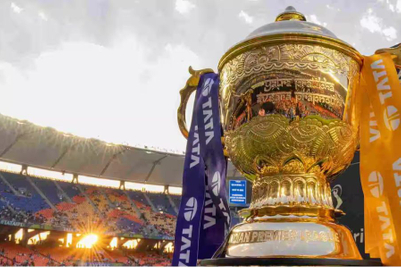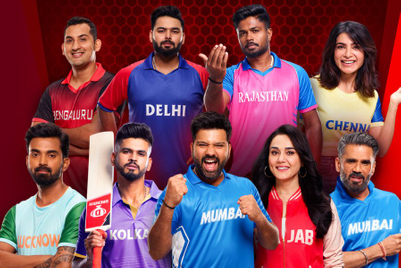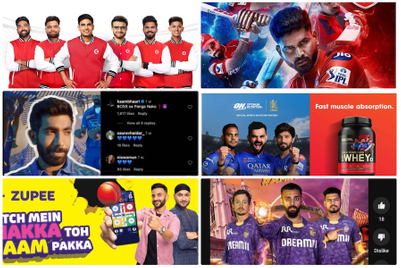.jpg&h=570&w=855&q=100&v=20250320&c=1)
When Finkeda’s chairman and managing director, Manish Kumar Goyal says, "We’re not just running ads—we've become part of the IPL story," he isn’t exaggerating. Especially after partnering with Gujarat Titans.
Over the past few seasons, the Indian Premier League (IPL) has outgrown the confines of sport to become a marketing juggernaut. With projected advertising revenues hitting INR 6000 to INR 7000 crore this year, as per an Integral Ad Science (IAS) report, it isn't just India’s biggest sporting event; it's where the real advertising battles play out.
But here's the twist: While the big bucks chase live broadcasts, fan attention is migrating elsewhere. According to the same report, Indian sports fans now spend 20% more time consuming non-live content than live matches. So, what does this mean for marketers who are still caught up in the thrill of the live screen?
"Connected TV (CTV) and digital platforms provide deeper, more interactive engagement," says Dream Sports’ chief marketing officer, Vikrant Mudaliar. And the data backs him up. 74% of marketers believe CTV ads paired with live sports outperform traditional sponsorships.
Yet, here’s the kicker: 17% of CTV impressions may be wasted when TVs are off. So, while the game is on, your ad might be playing to no one.
"We’re re-evaluating our media optimisation strategies," says Nitin Naresh, managing director of Magnon Designory, while talking about how they are reevaluating their clientele’s marketing plans. He highlights the importance of advanced viewability metrics—like screen presence and audibility—over raw impressions. Device-level verification, server-side ad insertion (SSAI) data and automatic content recognition (ACR) are now critical in ensuring ads reach actual eyeballs.
Performance over presence
Gone are the days when visibility alone meant success. This IPL season, performance KPIs have taken centre stage. Marketers are drilling down into engagement metrics, brand recall, and organic conversation spikes.
“If we can spark conversations, drive participation and strengthen our community, that’s a win,” says Mudaliar. Dream11, for instance, is banking on emotional resonance through initiatives like the Naman Awards, which honour cricket legends.
For Snap Inc., it's about moving beyond the passive viewer. "Gen Z doesn’t just watch sports; they co-create, share, and engage," explains its head of ad revenue, Neha Jolly Sawhney. Snapchat's immersive AR Lens partnership with JioCinema offered live score updates and character animations triggered by match moments. It's not an ad; it's a celebration.
High spends, low recall
Despite the advertising flood, recall remains patchy. The eDART-IPL25 study tracked over 130 brands across 20,000 respondents and found most viewers remember just two to eight brands. According to Hansa Research’s executive vice president and head of Quantitative Research Division, Sandeep Ranade, people want to watch the game, not decode ads.
“IPL has evolved over the years to attract diverse audiences and we have started seeing categories like fashion, food and beverages etc. (which do target women as a TG) also advertise on IPL. Data from IPLOmania Study conducted by Hansa Research, shows that brands in categories like food and beverages, fashion and cosmetics see a significant uplift in awareness (> 15%),” he stated.
Even within high-spend categories, results vary. Fantasy sports brands dominate recall (66%), followed by tyres (32%). But at the bottom end, only 1% recall a sports and fitness brand.
Hence, brands must remain rooted in their core positioning, even when adapting messages. OTT platforms enable sharper targeting than linear TV by leveraging demographic, behavioural, or contextual data. This facilitates tailored messaging that resonates with the target group, driving stronger recall—even with lighter media spends—compared to high-spend categories like fantasy sports.
This also throws a spotlight on the messaging, not just media budgets. "The creative plays a large role in breaking clutter," notes Interspace Media CEO Nikhil Rangnekar, who applauds Dream11's sharp storytelling while critiquing the underwhelming work by competitors.
Category Context Matters
In some categories, strong consumer interest naturally boosts brand recall. Fantasy sport, however, relies on heavy media spending to achieve this, with 52% showing interest. Among IPL audiences, engagement levels vary by category, influencing how well brands register.
"There’s wide dispersion in interest levels among IPL viewers," adds Ranade. Categories like OTT (66%), payment apps (46%) and electronics (46%) attract far more attention than fitness or fashion. Goyal sees this as a cue for segmentation: "We use local languages and relatable messages on CTV and OTT so our ads feel personal, not generic."

Rangnekar is of the view that tyres lack inherent category affinity. Ceat, however, has carved out distinct visibility through its association with the IPL’s strategic timeout. He adds that leveraging consumer behaviour through data and tech—using research to identify key behavioural segments and tech to precisely target them—can sharpen media strategy and improve effectiveness, even in categories where natural consumer interest is low.
Rangnekar suggests aligning content with viewer preferences. "Brands like Thums Up can target viewers who favour action or thriller genres. OTT allows for that level of precision," he states.
Meanwhile, Mudaliar says Dream Sports remains 'idea-first' in its approach. "The creative idea defines the need for celebrity involvement and guides our storytelling. Cricketers, given our deep connection to the sport, naturally fit into our storytelling. When we work with entertainment stars, it’s primarily because they enhance the creative idea. Their celebrity status is an added benefit,” he added.
Optimising for attention, not impressions
Simply flooding a screen with inventory doesn’t work anymore. "We focus on sharper messaging rather than increasing budgets," says Mudaliar.
The goal? Content that resonates, sparks participation, and travels organically. For Goyal, the hack lies in syncing TV ads with mobile activations, especially during exciting match moments. QR codes and regional offers bridge the engagement gap.
Snap Inc. has gone further. Its 'Lean Back', 'Lean In' and 'Opt-In' formats are tailored for different attention levels. "We ensure brands land on the right screen, not the ignored one," Sawhney says. A Snap Ad in Stories may serve passive consumption, while an AR Lens demands active engagement.

Viewability is undergoing a radical overhaul. Magnon Designory now prioritises attention-based metrics: screen-time, action rates, completion. With SSAI and ACR tools, ads are served during high-attention windows—like innings breaks. "We want to know if the ad was seen, heard, and remembered," Naresh asserts.
And it’s not just about CTV. Rangnekar stresses the value of OOH (out-of-home) advertising for reaching mobile, male IPL fans. "OOH serves as a reminder medium closer to purchase,” he notes. It might lack interactivity, but makes up for it in frequency and placement.
The evolving media mix
Linear TV still holds sway for reach, but OTT and CTV offer better targeting. “We ensure every channel works efficiently to contribute to the campaign’s overall success,” says Mudaliar. The secret? A judicious blend of live action and pre/post content. Even shorter ad durations (ACDs) during high-intensity moments have proven impactful.
Ranade underscores that OTT platforms enable brands to deliver personalised communication, especially with lower media weights. "This is helping brands in non-traditional categories build recall without outspending giants."
As the IPL ecosystem matures, so must the advertising strategies built around it. High spend doesn’t guarantee recall. Viewability isn’t just about being visible. And digital isn’t merely a checkbox in the media plan.
The new playbook for IPL advertising demands adaptive creativity, smarter placement, and obsessive focus on attention metrics. As long as the league continues to evolve, brands must keep pace not just with the game, but with the fan in front of the screen—live or not.
In a tournament where every ball can change the match, every second of audience attention could be the difference between a one-time view and long-term brand love. The game is on, and so is the battle for relevance.


.jpg&h=334&w=500&q=100&v=20250320&c=1)
.jpg&h=334&w=500&q=100&v=20250320&c=1)

.jpg&h=334&w=500&q=100&v=20250320&c=1)


.jpg&h=334&w=500&q=100&v=20250320&c=1)


.jpg&h=334&w=500&q=100&v=20250320&c=1)







.jpg&h=268&w=401&q=100&v=20250320&c=1)
